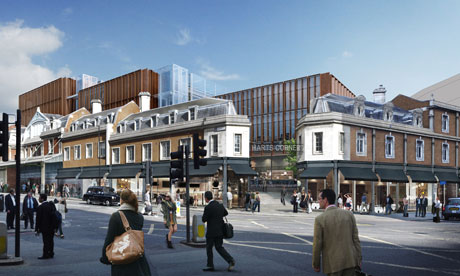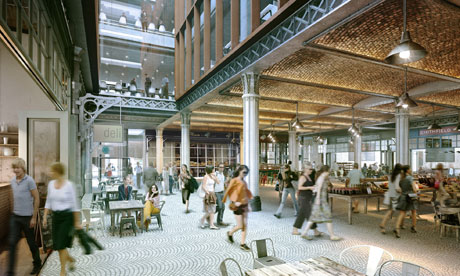SAVE Britain’s Heritage has revealed rival plans for the overhaul of London’s Smithfield Market
Drawn up Burrell Foley Fischer, the scheme is being billed as a viable alternative to John McAslan + Partner’s concept for the site which the group claim would destroy all but three facades of the historic - but unlisted - market.
John McAslan unveiled its latest proposals for the problematic plot last month and has been working with current owners Henderson Global Investors on the retail and office-led plans for the General Market, Fish Market and Red House buildings since summer 2010. A previous, highly controversial proposal for the historic site designed by KPF, which would have seen much of the existing Victorian buildings flattened, was famously rejected by Communities Secretary Hazel Blears in August 2008 following a four-year battle.
Despite support from English Heritage, the McAslan plans have been heavily criticised by SAVE which said the proposals ‘merely nod at conservation’ and sacrificed the roof.
According to SAVE, the UK Fashion Hub, one of the bidders for the Olympic Media Park, has already thrown its weight behind the ‘conservation-led scheme’.
Marcus Binney, President, SAVE Britain’s Heritage, comments:
Victorian covered markets with their lofty iron and glass roofs have long been popular landmarks in cities all over Europe. Yet, for the last five decades they have been an increasingly vanishing breed.
The biggest scar on Paris’s reputation as the world’s most beautiful capital was the futile destruction of Victor Baltard’s unrivalled market buildings at Les Halles, carried out in 1971 by an obstinate government against passionate opposition from Parisians.
In London, let it never be forgotten, the Greater London Council’s grand plan was to bulldoze a six-lane highway, parallel with the Strand, through the middle of Covent Garden destroying all the market halls.
Thirty years ago the City Corporation was set on the demolition of old Billingsgate Fish Market on the Thames, also designed by Sir Horace Jones. SAVE fought these proposals and produced an alternative scheme with Chrysalis Architects supported by the Richard Rogers Partnership. Today, old Billingsgate Market, so similar architecturally to Smithfield General Market, flourishes as an events venue and served as the Maison de France during the London Olympics.
The challenge SAVE now lays down to the City Corporation and Henderson Global Investments is this: do not join the ranks of the villains who have destroyed so much of historic London including the Victorian Coal Exchange.
SAVE fought and won the public inquiry into the previous proposals to demolish the General Market, standing shoulder to shoulder with English Heritage. Now English Heritage, remarkably, appear to be ready to sacrifice Horace Jones’ interiors in the General Market, allowing them to be stripped of their impressive Phoenix columns and glass and timber roofs.
English Heritage appears willing to accept the developer’s claim that the conservation deficit is such that it is necessary to gut the whole market building leaving only three facades (not the fourth, which will be destroyed), and small sections of roofs and dormers without their lively chimneys.
For SAVE, the architect John Burrell has prepared this visionary alternative. Eric Reynolds and Ian Lerner, two longstanding champions of Smithfield Market, and key witnesses in the 2008 Public Inquiry, both emphasise that retail space brings higher rentals than offices. The empty and grim offices on Farringdon Road are proof that the area does not need more of them. In addition, Hendersons Global Investors are planning to construct a nine-storey office block opposite the General Market, making their plans for this historic site greedy as well as mad.
The Smithfield quarter, like Covent Garden before it, has come to life thanks to natural regeneration as small businesses have colonised every vacated premise in the streets around the market buildings. This is creating one of central London’s liveliest districts, full of both traditional character and new life. Fashion Hub UK has come forward as an enlightened company, ready to back a conservation-led scheme.
Wake up City planners and Aldermen! Smithfield Market ranks as one of London’s chief public spaces that should be serving the city and its visitors, as the capital’s newest hub.
















